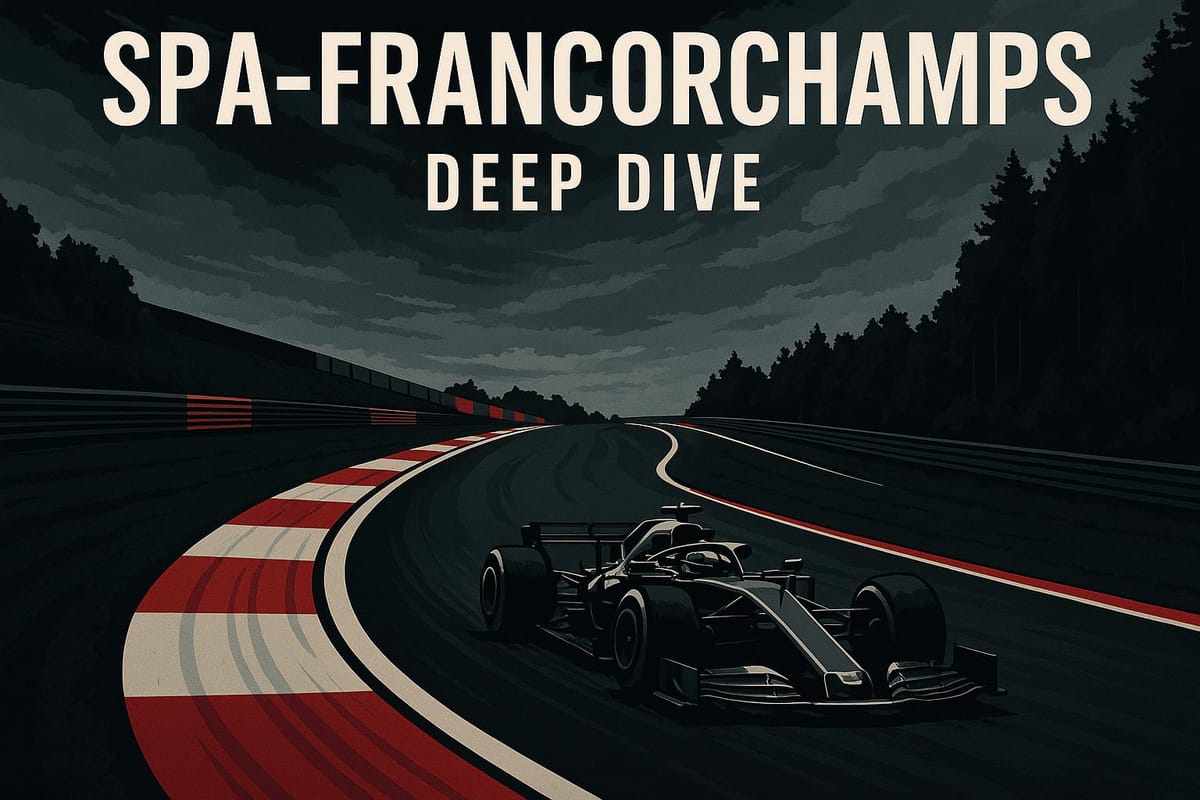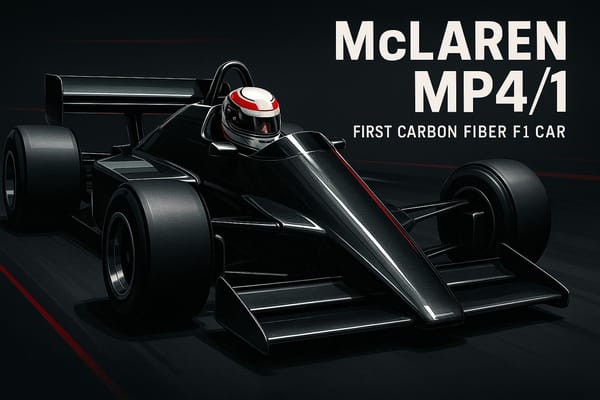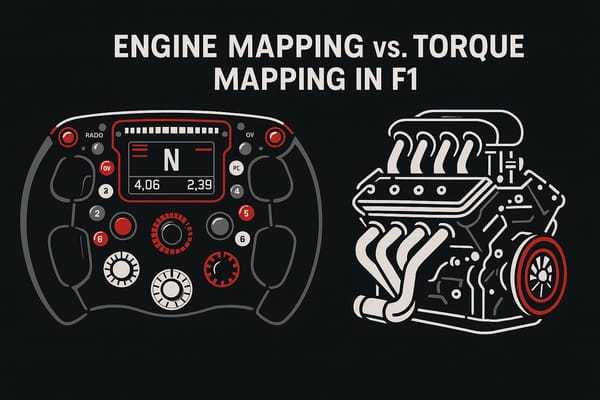Spa-Francorchamps Deep Dive: The Drama, Danger, and DNA of Belgium’s Legendary Track
Explore the rich history, challenges, and iconic moments of Spa-Francorchamps, the ultimate test track in Formula One racing.

Spa-Francorchamps is Formula One’s ultimate test track. Known for its 4.35-mile length, demanding corners like Eau Rouge and Raidillon, and unpredictable Ardennes weather, it challenges drivers and teams like no other circuit. With a history dating back to 1925, Spa combines rich tradition with intense racing drama. It’s where legends are made, champions are tested, and motorsport history is written.
Key Highlights:
- Longest F1 track on the calendar at 4.35 miles (7.004 km).
- Famous for dramatic elevation changes of 335 feet (102.2 meters).
- Iconic corners: Eau Rouge, Raidillon, and Pouhon.
- Unpredictable weather often changes mid-race, impacting strategy.
- Safety has evolved significantly, but challenges remain.
Spa is not just a racetrack - it’s a proving ground for skill, endurance, and innovation in Formula One.
The History of Spa-Francorchamps

Early Years and First Races
Spa-Francorchamps traces its roots back to the 1920s, when three visionaries - Jules de Thier, Henri Langlois van Ophem, and Baron Joseph de Crawhez - envisioned a racing circuit that would connect the towns of Spa-Francorchamps, Malmedy, and Stavelot. The result was a massive triangular layout spanning approximately 14.9 km (9.3 miles) through Belgium's picturesque Ardennes region.
However, the circuit's debut didn’t go as planned. The first race, set for 1921, had to be canceled due to a lack of participants. Instead, a motorcycle race marked the track's opening. It wasn’t until 1922 that Spa hosted its first official Belgian Grand Prix, and by 1924, the circuit expanded its repertoire with the introduction of a 24-hour endurance race.
In its early days, Spa was notorious for its challenging layout. Public roads twisted through dense forests, with no safety barriers or run-off areas to protect drivers. Jackie Oliver once remarked:
"If you went off the road, you didn't know what you were going to hit".
The circuit's danger was epitomized by corners like the infamous Masta Kink. Jackie Stewart famously described it as:
"By far the most difficult corner in the world".
These early challenges underscored the need for ongoing innovation, especially as safety concerns grew more pressing.
From Public Roads to Modern Circuit
The evolution of Spa from a perilous public road course to a modern racing facility was a gradual process, shaped by safety concerns and driver protests. A pivotal change occurred in 1939, when the hazardous "Virage de l'Ancienne Douane" (Customs hairpin) was removed. This modification introduced the Raidillon corner, which connected Eau Rouge to the Kemmel straight and created the iconic uphill sweep that defines Spa today. With its steep 17% incline, Raidillon became a formidable challenge for both cars and drivers.
Post-World War II, additional adjustments were made, including replacing the dangerous Stavelot intersection with a fast, banked corner. Despite these efforts, the circuit remained treacherous, and by 1970, no major safety upgrades had been implemented.
The tipping point came in 1969, when Formula 1 drivers boycotted the Belgian Grand Prix over safety concerns. Henri Pescarolo's lap record of 3 minutes and 13.4 seconds on the original layout stood as a stark reminder of the blistering speeds - and risks - associated with the track.
In 1979, Spa underwent its most dramatic transformation. The circuit was shortened from 14.1 km to 6.947 km (4.3 miles), turning it into a permanent racing facility while preserving its fast, hilly character. By 1981, the start/finish line was relocated to the straight before the La Source hairpin, establishing the layout that remains central to the circuit today.
Each safety improvement helped shape Spa into the modern racing venue it is now, without losing the essence that makes it a favorite among drivers. These changes not only addressed safety concerns but also cemented Spa’s reputation as the ultimate test of skill and endurance.
Famous F1 Races at Spa
Over the years, Spa's demanding layout and unpredictable weather have produced some of Formula 1's most iconic moments. The circuit's F1 journey began in 1950, with Juan Manuel Fangio claiming victory at the first Belgian Grand Prix held there. It was the events that followed, however, that truly solidified Spa’s legendary status.
The track became synonymous with separating exceptional drivers from the rest. Michael Schumacher earned his first Formula 1 win at Spa in 1992, driving for Benetton under wet and treacherous conditions - a performance that highlighted both his talent and Spa's reputation as a proving ground.
Ayrton Senna’s mastery of Spa, particularly in the rain, became the stuff of motorsport legend. His uncanny ability to navigate the track’s unpredictable conditions further reinforced the circuit’s status as a place where champions are made.
Spa’s notoriously capricious weather has consistently been a game-changer. Different parts of the 6.9 km circuit often experience varying conditions at the same time, forcing teams and drivers to adapt in real-time. These split-second decisions can make or break a race - and even decide championships.
In 2007, Spa underwent further modernization. The Bus Stop chicane was moved closer to Blanchimont, and the La Source hairpin was repositioned to extend the start/finish straight. These updates created space for a new pit lane and improved both safety and the overall racing experience.
Today, Spa-Francorchamps remains a favorite among drivers and fans alike. Its dramatic 104-meter (341-foot) elevation changes continue to challenge even the most advanced Formula 1 cars, while its ever-changing weather ensures that every race is a unique spectacle.
Spa Francorchamps: The Definitive Circuit Guide
Track Design and Racing Challenges
Spa-Francorchamps is a circuit that pushes both drivers and cars to their limits. Stretching 6.9 km (4.3 miles) through the Ardennes forest, its layout is as challenging as it is iconic. Unlike many modern tracks, Spa embraces the natural terrain, creating a course that demands skill, precision, and endurance.
One of Spa’s defining features is its dramatic elevation changes - the steepest on the Formula 1 calendar. With a staggering 335 feet (102.2 meters) difference between its highest and lowest points, the track presents unique aerodynamic and mechanical hurdles. These challenges are most evident in its legendary corners.
Key Corners: Eau Rouge, Raidillon, and Pouhon
The Eau Rouge and Raidillon complex is perhaps Formula 1’s most famous sequence. Eau Rouge is a sharp left-hand kink at the base of a hill, leading into Raidillon’s sweeping uphill right-hand curve, which climbs at a 17% gradient. This section alone features a 134-foot (40.8-meter) elevation change, with cars reaching speeds of nearly 186 mph (300 km/h).
The technical demands here are immense. Drivers enter Eau Rouge at roughly 112 mph (180 km/h) in fourth gear, navigating through the compression phase while enduring vertical forces of up to 5g. By the time they exit Raidillon, speeds climb to 193 mph (310 km/h). This rapid transition from downhill to uphill puts extreme stress on the car’s suspension and aerodynamics. To handle these forces, teams adjust the front ride height to prevent bottoming out, which could cause a dangerous loss of control.
Pouhon, another standout corner, offers a different challenge. This double-apex left-hander begins with a downhill approach at 180 mph (290 km/h) in seventh gear. Drivers must maintain 162 mph (260 km/h) through the mid-section, all while battling lateral forces of up to 4.5g. Exiting at 168 mph (270 km/h) in sixth gear requires flawless steering and throttle control.
Elevation Changes and Weather Effects
The track’s steep gradients and undulating terrain force engineers to design setups that can handle both high-speed straights and sudden elevation shifts. These changes affect suspension compression, car balance, and grip, making a one-size-fits-all setup impossible. Additionally, blind corners created by the elevation shifts demand drivers rely on instinct and memory rather than sight. Red Bull's Alex Albon once remarked:
"Running this, I can tell you from experience, is a killer! It's not one of the best circuits to do your track runs on."
The physical toll on drivers is immense, with constant g-force variations requiring exceptional neck and core strength. These grueling demands underscore Spa’s reputation as a true test of skill and endurance.
Adding another layer of complexity is Spa’s microclimate, which can change dramatically across the track. During the Belgian Grand Prix, temperatures typically range from 59°F to 77°F (15°C to 25°C), but sudden rain showers and high humidity are common. This unpredictability makes tire strategy a nightmare. Pirelli’s racing manager, Mario Isola, explained:
"Teams must be flexible to adapt the strategy from what they see in the race."
Despite advanced weather modeling, race-day decisions often hinge on real-time observations and constant communication.
Track Layout Pros and Cons
Spa’s design offers a mix of opportunities and challenges. Its unique combination of natural terrain, elevation changes, and unpredictable weather shapes both race strategies and risks. Here’s a breakdown of its strengths and weaknesses:
| Advantages | Disadvantages |
|---|---|
| Multiple overtaking opportunities on Kemmel Straight | Limited run-off areas in high-speed sections increase crash risks |
| High-speed layout rewards aerodynamic efficiency and engine power | Elevation changes force setup compromises |
| Weather variability can create strategic openings for underdog teams | Microclimate conditions complicate tire strategy |
| Long lap length reduces traffic during qualifying | Physical demands from elevation shifts strain drivers |
| Natural terrain features reward driver skill | Blind corners increase safety risks |
| Corners like Pouhon test aerodynamic balance | Setup trade-offs can hurt performance on other circuits |
At 6.9 km, Spa is one of the longest tracks on the calendar, meaning cars spend more time at high speeds compared to shorter circuits. Teams must strike a delicate balance between downforce for corners and straight-line speed. This compromise is often the difference between success and failure at Spa. Max Verstappen captured this sentiment after a practice session:
"It is always very tricky to find the right balance when you are trying a few things to see what is better. We'll look at it on the data and analyse the day in debrief. We started off quite positively today and have some things to work on from FP2, so there are a few things to look at."
The constant need to adapt and fine-tune setups makes Spa one of the most technically challenging circuits in Formula 1.
Safety Evolution at Spa-Francorchamps
Spa-Francorchamps has long been known for its mix of breathtaking speed and unforgiving conditions. Over the decades, the circuit has earned a reputation for its danger, with high-speed crashes and tragic accidents shaping its legacy. Its fast straights, blind corners, and unpredictable weather have not only tested drivers' skills but also driven some of the most critical advancements in motorsport safety. From its early days as a public road circuit with minimal protections to the modern facility we see today, Spa's story is a blend of triumph and tragedy.
The circuit's influence on Formula 1 safety extends far beyond Belgium. Major incidents at Spa have forced the sport to confront its risks, leading to sweeping changes in car design, track infrastructure, and racing regulations. These changes have become as much a part of Spa's identity as its iconic corners and challenging conditions. However, many of these safety measures were born from moments of heartbreak on the track.
Major Accidents and Their Consequences
One of the most somber moments in Spa's history occurred during the 1960 Belgian Grand Prix, where two drivers, Chris Bristow and Alan Stacey, lost their lives in separate crashes during the same race. The original 8.8-mile circuit, which ran on public roads, offered little in the way of safety barriers or medical support, underscoring the extreme dangers of the era.
A pivotal moment for safety came in 1966 when Jackie Stewart suffered a harrowing crash in wet conditions. Trapped in his car soaked with fuel for over 20 minutes, with no proper rescue tools or marshals nearby, Stewart's ordeal became a catalyst for change. He became a relentless advocate for improvements such as seatbelts, better helmets, and safer circuits. His campaign reached a peak in 1969 when he led the Grand Prix Drivers' Association (GDPA) in boycotting the Belgian Grand Prix due to a lack of safety upgrades.
In 1993, Alex Zanardi experienced a terrifying crash at Eau Rouge when his car's active suspension failed, sending him into the barriers at immense speed. Despite enduring forces 18 times greater than what is typically fatal and suffering a severe concussion, Zanardi survived. More recently, the tragic death of Formula 2 driver Anthoine Hubert in 2019 at Raidillon profoundly impacted the racing world. His car struck the barriers and rebounded onto the track, leaving no time for other drivers to react. The FIA's investigation concluded that:
"The investigation found no evidence that any driver failed to react appropriately in response to the yellow flag signal or to the circumstances on track."
This incident prompted the FIA to implement stricter crash tests for cars across Formula 1, F2, F3, and Formula E. They also focused on improving side-impact protection and introduced new tethers to prevent debris from detaching during collisions.
The most recent tragedy occurred in July 2023, when Dilano van't Hoff lost his life during a wet Formula Regional race. His crash, eerily similar to Hubert's, reignited debates about racing in poor visibility and wet conditions, highlighting the ongoing challenges of safety at Spa.
Safety Improvements Over Time
In response to these tragedies, Spa-Francorchamps has undergone significant transformations. The circuit's evolution from a public road layout to a modern racing venue reflects decades of safety-focused changes. Each incident has pushed the boundaries of safety technology and track design.
In 1970, Armco barriers replaced the stone walls and trees that had made crashes so deadly. During the 1980s and 1990s, further improvements were made, including the addition of a chicane at the old Clubhouse corner in 1981. After Zanardi's crash in 1993, a temporary chicane was added at Eau Rouge in 1994, later replaced with expanded run-off areas in 1995.
The 2000s brought even more upgrades. In 2007, the F1 pit facilities were completely rebuilt, the Bus Stop chicane was redesigned, and the main straight to La Source was extended. Former public roads were permanently closed off.
A massive €80 million renovation in October 2020 brought Spa up to FIM Grade C standards. This project combined €21 million in circuit funds, a €29.5 million bank loan, and another €29.5 million investment from Sogepa. Further upgrades in 2021 and 2022 added gravel traps and expanded run-off areas at key corners such as La Source, Raidillon, Blanchimont, Les Combes, and Stavelot. These changes have significantly improved safety margins while preserving the track's legendary layout.
Despite these extensive efforts, concerns remain. Drivers like Jack Aitken have pointed out the lingering challenges at Eau Rouge, while Lance Stroll and Pierre Gasly have emphasized the risks of poor visibility in wet conditions. George Russell, speaking about the dangers of racing in heavy rain, remarked:
"We all want to race but when you're going down that straight at over 200mph and you can't see 50 meters in front of you, there will be huge incidents. So they have a big responsibility this weekend."
The ongoing dialogue between drivers, officials, and track designers ensures that safety remains a priority. Every improvement at Spa not only enhances the circuit but also sets new standards for Formula 1 tracks worldwide. These efforts honor Spa's rich history while ensuring it remains a thrilling yet survivable challenge for future generations of drivers.
Spa's Impact on Formula One

Spa-Francorchamps stands as a true test of driver skill, team strategy, and engineering ingenuity. This legendary circuit has consistently pushed the boundaries of what’s possible in Formula One, shaping both the drivers and the technology that define the sport.
A True Proving Ground
Spa-Francorchamps is often hailed as the ultimate proving ground for drivers and teams. In its earlier, more dangerous days before the safety modifications of the 1970s, the circuit’s fearsome reputation meant only the most determined and fearless drivers dared to compete. Back then, tackling corners at speeds exceeding 180 mph required not just skill but extraordinary mental resilience, often resulting in smaller grids.
The track’s signature corners, like Eau Rouge and Raidillon, demand precision and courage. Fernando Alonso once described the sheer complexity of navigating these turns:
"You come into the corner downhill, have a sudden change [of direction] at the bottom and then go very steep uphill. From the cockpit, you cannot see the exit and as you come over the crest, you don't know where you will land. It is a crucial corner for the timed lap, and also in the race, because you have a long uphill straight afterwards where you can lose a lot of time if you make a mistake. But it is also an important corner for the driver's feeling. It makes a special impression every lap, because you also have a compression in your body as you go through the bottom of the corner. It is very strange – but good fun as well."
Beyond individual challenges like Eau Rouge, Spa’s 4.35-mile layout forces teams to strike a delicate balance between low drag for the long straights and high downforce for the sweeping corners. The circuit’s unpredictable microclimate further complicates matters, often requiring teams to make rapid adjustments as conditions shift dramatically within a single session. These relentless demands have driven not only strategic evolution but also notable technical progress, such as the 4.3-second improvement in Sebastian Vettel’s fastest laps between 2013 and 2019.
By continuously testing the limits of both human and machine, Spa-Francorchamps remains a cornerstone of Formula One excellence.
An Icon in F1 History
The challenges posed by Spa-Francorchamps have solidified its place in Formula One lore. Despite modern updates, the 4.35-mile circuit has preserved its raw racing essence, standing as a benchmark for both drivers and engineers.
Over the decades, countless drivers have sung Spa's praises, cementing its legendary status. Ayrton Senna famously declared, "Eau Rouge is a man's corner", underscoring the respect and awe the track commands. Even today, drivers like Charles Leclerc emphasize the circuit's unforgiving nature:
"If you make a mistake, you pay for it – this is something we enjoy as drivers"
Spa’s unique combination of natural beauty, technical challenges, and historical significance continues to inspire innovation and elevate racing talent. Its enduring appeal ensures it remains one of Formula One’s most revered circuits.
Conclusion: Why Spa-Francorchamps Remains a Formula One Icon
Spa-Francorchamps stands tall as a timeless symbol of Formula One. Even after more than seven decades, this Belgian circuit continues to represent a blend of history, challenge, and sheer spectacle.
Stretching 4.35 miles, Spa is the longest track on the F1 calendar, with races spanning 44 laps. Its layout is a masterful mix of high-speed straights, dramatic elevation changes, and legendary corners. Whether it’s the exhilarating climb through Eau Rouge and Raidillon or the precision required at Pouhon, Spa pushes drivers and their cars to the absolute limit.
What truly sets Spa apart is its rich heritage. Originally carved from public roads in 1921, this circuit carries a legacy that modern, purpose-built tracks simply can’t replicate. Nestled deep in the Ardennes forest, Spa is also known for its unpredictable microclimate, where weather conditions can change in an instant, adding an extra layer of complexity to each race.
Drivers hold Spa in the highest regard, and for good reason. Triumphing here has defined some of the sport’s greatest careers, from Juan Manuel Fangio’s first victory in 1950 to unforgettable performances in more recent years.
While Spa underwent significant changes in 1979 to improve safety, it managed to retain its essence as one of the most demanding and rewarding circuits on the calendar. This careful balance between preserving tradition and embracing progress ensures that Spa remains a favorite for both drivers and fans, offering the same thrills that have captivated motorsport enthusiasts for generations.
As Formula One continues to expand globally, Spa-Francorchamps remains a cornerstone of the sport’s identity. It embodies the perfect mix of natural beauty, technical mastery, and racing tradition. For as long as drivers seek the ultimate challenge and fans yearn for authentic racing drama, Spa will hold its place as one of Formula One’s most cherished and respected circuits.
FAQs
Why is Spa-Francorchamps considered one of the most challenging tracks in Formula One?
Spa-Francorchamps is legendary for its demanding nature, blending high-speed straights, tricky corners, and weather that's anything but predictable. Nestled in the Ardennes Forest, the track often throws surprises at drivers with sudden rain showers, making every lap a test of skill and quick thinking.
At the heart of the circuit lies the Eau Rouge-Raidillon section - a breathtaking uphill sequence that challenges even the best. Modern F1 cars may take it flat out, but it still requires absolute precision and nerves of steel. With its long laps, dramatic elevation changes, and the strategic depth it demands, Spa remains one of the ultimate proving grounds in motorsport.
How has Spa-Francorchamps improved safety over the years to address its high-risk reputation?
Safety at Spa-Francorchamps
Over the years, Spa-Francorchamps has worked hard to shake off its reputation as one of motorsport's most dangerous circuits. One of the biggest changes came in 1979 when the track was shortened to 4.35 miles (7 km) to reduce the risks posed by high-speed sections. Hazardous areas were reworked, and run-off zones were expanded to give drivers more room to recover from mistakes. To further enhance safety, advanced barriers like TecPro and tire walls were introduced, offering better impact absorption.
More recently, the track has undergone additional upgrades aimed at aligning with modern safety standards while keeping its iconic challenges intact. These updates include stronger driver protection systems, improved facilities, and continuous adjustments to meet evolving safety regulations. Thanks to these efforts, Spa-Francorchamps remains an adrenaline-filled experience that prioritizes the safety of both drivers and spectators.
Why is the weather at Spa-Francorchamps so unpredictable, and how does it affect race strategies?
The Weather at Spa-Francorchamps: A Racer's Wildcard
Spa-Francorchamps is notorious for its ever-changing weather, thanks to its unique location in the Ardennes Forest. This region is known for its microclimate, where sudden rain showers, dense fog, or abrupt temperature shifts are all par for the course. What’s even more fascinating? It’s not uncommon for one section of the track to be drenched in rain while another stays completely dry. This creates a constantly shifting and unpredictable backdrop for racing.
For teams, these conditions mean staying on their toes. Tire choices and pit stop strategies can flip on a dime, and adapting race plans in real time becomes a necessity. Drivers, too, are put to the test, as they must quickly adjust their driving style to match the changing grip levels on the track. It’s this mix of uncertainty and adaptability that makes races at Spa-Francorchamps so electrifying, often delivering edge-of-your-seat drama and unexpected outcomes.
Related posts
- How Teams Adapt Aerodynamics for Spa and Monza
- Imola’s Resurrection: From Tragedy to Triumph at the Emilia Romagna Grand Prix Circuit
- Monaco Grand Prix Circuit Guide: The Prestige, Precision, and Pressure of F1’s Crown Jewel
- Suzuka’s Legacy: How Japan’s Iconic Figure-8 Circuit Became a Driver Favourite




